60th Field Hospital Unit History
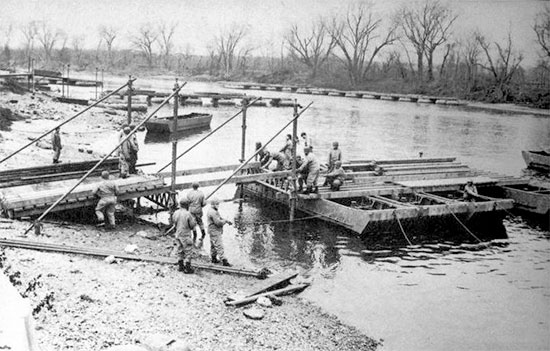
Winter of 1943. Engineers training at Camp Ellis, Fulton County, Illinois. Training activities took place between April 1943 and November 1944. Camp Ellis was a Unit Training Center, as well as a Replacement Pool for Engineer and Medical Officers, and a Prisoner-of-war camp. The installation was declared surplus category October 1, 1945.
Introduction:
The 60th Field Hospital was activated February 1, 1944, by re-designation of the 283d Station Hospital. Its first Officers or cadre, consisting of 1 MC Officer – 2 MAC Officers – and 1 DC Officer were members of the 283d Sta Hosp. The major portion of the Enlisted Men were drawn from the re-designated unit and the 341st Station Hospital which was inactivated at that time. Activation took place at Camp Ellis, Table Grove, Illinois (Army Service Forces Training Center; overall acreage 17,503; troop capacity 1,795 Officers and 24,654 Enlisted Men –ed).
Captain Roman C. Pauly assumed command on February 1. A few days later, Major Arthur T. Jones joined the organization and became the new Commanding Officer. The date was February 10, 1944.
The Enlisted personnel from the two units indicated above, approximated the numbers authorized by the T/O. Within one month, the Officer personnel gradually increased to 2 Medical Corps Officers – 3 Dental Corps Officers, and 5 Medical Administrative Corps Officers.
Training:
The men were classified and sent to various Schools so that they could qualify in the different specification numbers and MOS functions provided by T/O & E 8-510 dated September 28, 1943 which called for an aggregate strength of 230 personnel (22 Officers – 18 Nurses – 190 Enlisted Men –ed). Those members of the new command who had previously qualified were placed in the Post’s Station Hospital for gaining practical experience. The men not employed in the above two groups were placed in a Training Program run by the Hospital Officers themselves.

Aspects of Training in the Zone of Interior. Left: A Quartermaster Corps supply unit delivers items of equipment to troops in the field. Right: Servicemen line up for chow.
The newly-activated 60th Fld Hosp had been so picked that by the latter part of February 1944 it was able to transfer to the field and set up a two-week bivouac. During this occasion, the personnel, all of whom had previously operated under similar conditions were instructed regarding their individual duties. Since no guide or material for instruction were readily available, and since no one apparently knew the type of work the Field Hospital was to conduct, the staff and personnel were drilled and trained as 3 separate Hospital Units (the 3 Platoons could each operate individually and provide the necessary care and treatment for approximately 100 patients –ed). Fortunately, the focus was put on surgical nursing procedures, treatment of shock and general handling of patients. Each Hospitalization Unit repeatedly handled heavy tent pitching and striking and moving of the Aid and Clearing Stations.
Since the weather in Illinois was cold at this time of the year, the EM learned how to use their individual shelter tents to the best of their ability, and use heavy clothing and appropriate equipment under conditions more severe than they themselves had previously encountered and experienced in their native States.
The organization returned to its base camp about the middle of March 1944. Routine classes and lectures were resumed, some men were replaced in the Post Hospital and every available effort was made to allow everyone 10-days of furlough. The arrival and transfer of new personnel into the unit called for a slight reorganization. Many of the men recently transferred to the new Hospital had been released from the guard house on parole, and their only value was to allow Headquarters personnel the privilege of doing the paperwork required in a court martial. In spite of sincere efforts, none of these men would go overseas with the 60th Field Hospital. Consequently they had to be replaced by new Enlisted personnel from current General and Station Hospitals operating in the Zone of Interior.
The unit received all its ANC and MC Officers by April 15, 1944. An important inspection took place 2 days later, with the conclusion that there was a lack of professional and field experience among the Officers and the Nurses. The majority of them had simply been transferred from General and Station Hospitals, without much of a training! Moreover, many needed leaves since they had had no time to arrange personal matters prior to their joining the new Hospital for possible transfer for overseas service. Following this reorganization, the Officers were classified as best as possible and taken out in the field for additional vigorous training, lasting approximately from April 18 to April 24, 1944, during which everyone was put through exercises similar to those conducted in March and in line with the expected activities related to a Field Hospital. This was the only way to acquaint Officers and Nurses with actual field “problems”.
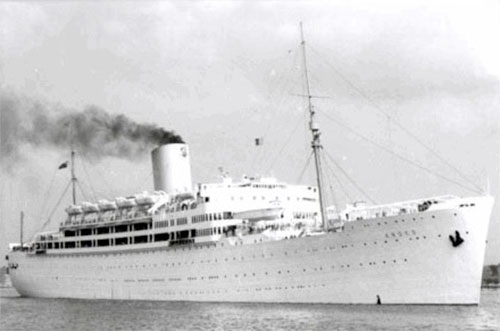
Picture illustrating HMT “Andes” (still in civilian guise), which carried the 60th Field Hospital overseas and to the United Kingdom where she arrived May 17, 1944.
Preparation for Overseas Movement:
Upon returning to Camp Ellis around end of April, the unit received alert orders to be ready and in Camp Kilmer, Stelton, New Jersey (Staging Area for New York Port of Embarkation; overall acreage 1,815; troop capacity 2,074 Officers and 35,386 Enlisted Men –ed), by May 2, 1944. This necessitated hurried final inspections of clothing and equipment, the immediate packing of TAT items, plus accomplishment of the many last minute details, such as final inoculations, paperwork, identification papers, required prior to sending a unit overseas. Fortunately, the responsible Medical Corps staff at Camp Ellis had instructed the Hospital to keep its records and paperwork up-to-date, so that not too much clerical work was to be done prior to departing the camp. The unit departed New York POE May 10, 1944 aboard HMT “Andes” (which sailed alone) arriving in the United Kingdom May 18, 1944 (actual arrival was May 17, but debarkation took place May 18, 1944 –ed).
United Kingdom:
The Atlantic crossing and further movement from Camp Kilmer to the United Kingdom was uneventful. The period spent in England lasted from May 18 to July 19, 1944.
The first six weeks were spent at Burton-on-Trent, Staffordshire, England, where the men were billeted in private homes nearby a small kitchen and mess hall, that had been established for the troops. As the TAT equipment was slow in arriving, it was felt that in order to maintain discipline and keep both Officers and Enlisted Men busy, a rigid daily routine was necessary. All personnel, including the female Officers, were required by the Commanding Officer to take part in marches, two or three times a week. Classes were organized and lectures given for the purpose of reviewing ordinary basic problems facing a medical soldier and provide him/her with the information and technique needed to accomplish his/her mission. The latter seemed quite vague to the members of the unit (due to lack of training in the ZI –ed). The division and operational aspects of the Hospital Headquarters (with a basic bed capacity of 380 –ed) and the 3 Hospitalization Units (maximum 100 patients each –ed) was stressed greatly during this period.

Vintage postcard illustrating “Bladon Castle”, Burton-on-Trent, Staffordshire, England.
The organizational equipment was late in arrival, being only drawn about the middle of July 1944. Upon arrival and inspection, it was immediately broken down into three separate sections. The necessary space was found with the assistance of the G-20 Depot and the British Billeting Officer, with installation sites to set up the 3 units. Everybody was assigned his specific duty. At this time, the command assumed that the 60th Field Hospital would care for the minor as well as for the major cases received by the organization, and consequently everything, including the operating rooms, was planned accordingly. The unit’s carpenters set to work, constructing mauls, sawhorses, benches, tables, etc. while other men and women manufactured light reflectors, painted GC Red Cross markers, and prepared blackout curtains.
A large wooded area was discovered near Repton, a village in South Derbyshire (some 4 ½ miles from Burton-on-Trent), where the unit could establish a tented camp. By pooling all motor transportation, the units were moved to this area. Prior to crossing over to the Continent, the 3 Hospitalization Units were all set up in the field and under tentage.
Cross-Channel Movement:
The movement to France was largely uneventful. Prior to crossing the English Channel, orders had been received assigning the 60th Field Hospital to General G. S. Patton, Jr. and his Third Army. Following debarkation, TUSA Headquarters had provided sufficient trucks to move the 3 Hospitalization Units complete to their bivouac site in Normandy. Meanwhile, the TAT equipment was placed on organizational transport and sent ahead with an advance party. Upon arrival the party partially established a camp, set up a kitchen and a mess, prepared the Nurses’ quarters, etc., and when the main group reached its assigned bivouac site near Carentan, France, on July 19, 1944, the tented camp was almost completed.
France:
The organization was to remain in bivouac until August 8, 1944. During this period, personnel were instructed regarding the care of non-transportable patients and the setup of holding units. Apart from reviewing some general aspects of medical care and treatment, physical conditioning was focused on and maintained by organizing two-weekly road marches for the entire personnel of the command. The unit equipment was inspected and found chiefly intact. Considerable time was spent rechecking the equipment, improving whatever was necessary, and manufacturing or requisitioning any extra items that were deemed necessary and were not covered by the T/E. As a matter of fact problems relating to the procurement of certain items authorized the unit never ceased to exist during the active period of the Hospital’s stay on the Continent.

Map describing the Battle for Carentan, France, June 8-12, 1944.
On August 9, 1944, the unit moved to a new site near Vitré, France (between Rennes and Laval, Brittany –ed). The Second Hospitalization Unit was the first to be committed. It went to Angers to support the 5th Medical Battalion Clearing Station (5th Infantry Division) starting August 10. Since no additional Surgical Teams were available, a Surgeon was transferred from another Hospitalization Unit, and the Nurses attached to Hospital Headquarters were sent over to help. During the very first few hours, Second Platoon received 21 patients. The Third Hospitalization Unit (or Third Platoon) was sent to assist Second Platoon on August 11, and relieved them when the 5th Infantry Division moved from Angers. After this first operation, additional Surgical Teams were assigned to the three Platoons thus enabling them to handle the non-transportable wounded adequately.
The mission of the 60th Field Hospital mainly consisted in removing from the evacuation chain those patients unable to stand further handling and movement. Chest and abdominal wounds were prominent. However, certain injuries of the extremities, the central nervous system, the skin and muscles, were so severe as to place such cases in this category. The organization placed these individuals in the proper condition required to move them to the rear. Two Shock Teams were on standby for this purpose. Meanwhile other selected personnel were available to furnish the supportive care to enable such patients to gain strength required for their removal to the rear. Holding Units were therefore set up to free other personnel for specific Field Hospital duties.
1944 Operations (remarks and recommendations)
Following investigation of the unit’s first operations some important recommendations were made.
Sufficient transport should be attached to Hospital Headquarters to move a single Hospitalization Unit, including all personnel and organization equipment.
The Hospitalization Unit (or Platoon) as issued proved itself inadequate since it was limited and equipped for operating a max. 100-bed hospital plant. Since as many as 26 procedures a day were conducted, a great deal of necessary equipment was not available. The T/E was to be reviewed and amended to include more surgical instruments, chests, anesthesia apparatus, and sets for brain and spinal injuries. In fact this was never done before the war’s end.
Generators were to be added by supplying a generator truck or trailer. It was discovered that British collapsible surgical tables were better than those issued by the Army’s Medical Department. Since chest wounds required oxygen in large quantities, it was recommended to supply more masks to administer oxygen. Due to the lack of beds and/or folding cots, horses and litters were often used as a means of support during surgery.
Providing extra white lining for the surgical tents was widely recommended, but it was also stressed that these liners were to be manufactured by other means than the Nurses working with a sewing machine. Blackout doors or panels for the tent entrances became an urgent necessity, and again, alternative and cheaper sources were to be investigated in order to avoid soldiers busying themselves with improvised canvas and poles in numerous ways.
The use of light packing material for field use was to be studied as it could eliminate heavy boxes and reduce the quantity of truck space more efficiently.
Personnel training was difficult and complex because the Hospitalization Units were often used in the field as Holding Hospitals handling a large number of non-transportable cases. The corresponding care and treatment of severe chest and abdomen injuries required more personnel and more equipment, therefore it was decided to prepare dummies, diagrams, dry runs, and classes for improving skills and techniques, as well as discipline in the command. Besides nursing and servicing, a number of Enlisted personnel were to be taught to assist in the OR. Special courses for Medical / Surgical Technicians, laboratory staff, x-ray operators, mess sergeants, supply sergeants, and other personnel of the command were to begin right away, preferably before the organization was deployed or became operational.
It was concluded that Field Hospital functions worked more smoothly under tentage, provided ordinary climatic conditions prevailed, when compared to buildings. Of course, cold weather made it sometimes necessary to use more permanent shelter. Tents however, could be kept warm and dry, during rather severe winter periods, provided certain measures were taken and the necessary modifications authorized (winterization of tentage –ed).
The lack of proper recreation caused some concern. This was quite severe with Nurses who in a period of heavy operation could do little but continue to work and catch sleep as and when they could. Shifting from OR to other activities remained difficult (different skills and different knowledge were required) since only one Surgical Nurse was present in each Platoon. The consequences were that some of the very excellent ANC Officers became short tempered or stressed while serving on the wards. Short passes offered some relief, but could only be awarded during inactive phases. One of the greatest morale boosts to all was the mail call, the steady issue of cigarettes, and the availability of sufficient PX supplies.
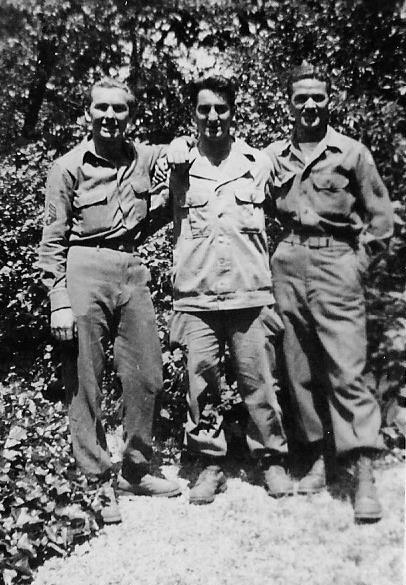
Personnel of the 60th Field Hospital. From L to R: Alfred J. Francis, 33594442; Vincent Dendrea, 32959516; Robert J. Carroll, 32605096 (all members of the Second Hospitalization Unit).
Operations Outline (period August 19, 1944 > December 31, 1944)
First Platoon
Mortrée, France – August 19 to August 25, 1944. Supporting: 80th Infantry Division. Total Admissions: 99.
Marigny, France – August 28 to August 29, 1944. Supporting: 80th Infantry Division. Total admissions: 3.
Vignot, France – September 1 to September 3, 1944. Supporting: 80th Infantry Division. Total Admissions: 8.
Beaumont, France – September 4 to September 15, 1944. Supporting: 80th Infantry Division. Total Admissions: 56.
Cerceil, France – October 9 to November 5, 1944. Supporting: 26th Infantry Division. Total Admissions: 41.
Athienville, France – November 7 to November 13, 1944. Supporting: 26th Infantry Division. Total Admissions: 126.
Vie-sur-Seille, France – November 14 to November 21, 1944. Supporting: 26th Infantry Division. Total Admissions: 115.
Dieuze, France – November 22 to November 30, 1944. Supporting: 26th Infantry Division. Total Admissions: 42.
Château de Bonnefontaine, France – December 1 to December 10, 1944. Supporting: 26th Infantry Division. Total Admissions: 53.
Oerlingen, France – December 11 to December 25, 1944. Supporting: 87th Infantry Division. Total Admissions: 122.
Bastogne, Belgium – December 28 to December 30, 1944. Supporting: 101st Airborne Division. Total Admissions: 94.
Highest Admissions in one day: 57. Total number of Admissions for above period: 759.
Second Platoon
Bécon-les- Granits, France (approximately 11 miles from Angers) – August 10 to August 18, 1944. Supporting: 5th Infantry Division. Total Admissions: 32.
Martincourt, France – September 12 to September 24, 1944. Supporting: 80th Infantry Division. Total Admissions: 115.
Dieulouard, France – September 25 to October 31, 1944. Supporting: 80th Infantry Division. Total Admissions: 93.
Millery, France – November 1 to November 10, 1944. Supporting: 80th Infantry Division. Total Admissions: 40.
Brulange, France – November 19 to November 23, 1944. Supporting: 80th Infantry Division. Total Admissions: 16.
Charbonnages, France – November 24 to December 8, 1944. Supporting: 80th Infantry Division. Total Admissions: 64.
Bissen, Grand-Duchy of Luxembourg – December 24 to December 31, 1944. Supporting: 80th Infantry Division. Total Admissions: 45.
Highest admissions in one day: 28. Total number of admissions for above period: 405
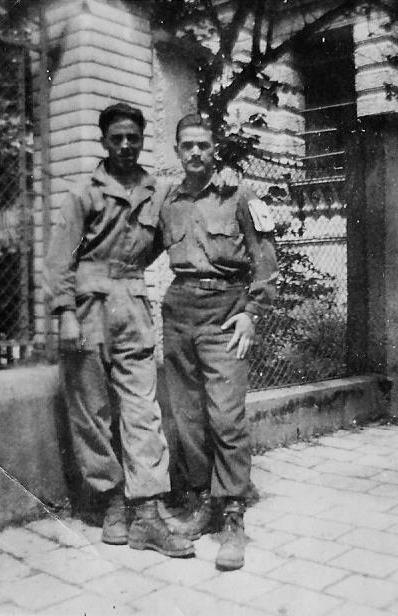
Another picture illustrating some personnel of the 60th Field Hospital. From L to R: Peter J. Devito, 32889858 and Robert J. Carroll, 32605096 (also of the Second Hospitalization Unit).
Third Platoon.
Malesherbes, France – August 23 to August 24, 1944. Supporting: 5th Infantry Division. Total Admissions: 28.
Reims, France – August 25, 1944. Supporting: 5th Infantry Division. Total Admissions: 2.
Vézelise, France – September 11 to September 13, 1944. Supporting: 35th Infantry Division. Total Admissions: 23.
Bayon, France – September 14 to September 17, 1944. Supporting: 35th Infantry Division. Total Admissions: 30.
Harcourt, France – September 18 to September 25, 1944. Supporting: 35th Infantry Division. Total Admissions: 29
Saint-Max, France – September 26 to November 7, 1944. Supporting 35th Infantry Division. Total Admissions: 110.
Bioncourt, France – November 8 to November 18, 1944. Supporting: 35th Infantry Division. Total Admissions: 74.
Morhange, France – November 19 to December 2, 1944. Supporting: 35th Infantry Division. Total Admissions: 57.
Saint-Jean-Rohrbach, France – December 4 to December 5, 1944. Supporting: 35th Infantry Division. Total Admissions: 4.
Puttelange, France – December 6 to December 14, 1944. Supporting: 35th Infantry Division. Total Admissions: 55.
Lixigen, France – December 15 to December 23, 1944. Supporting: 6th Armored Division. Total Admissions: 10.
Highest Admissions in one day: 22. Total number of Admissions for above period: 422.
Totals for the 3 Platoons.
Maximum Admissions in one day: 94. Grand total number of Admissions: 1586.
1945 Operations (remarks and recommendations)
Following the outbreak of the German counter-offensive in the Belgian Ardennes (December 16, 1944), the intense and severe fighting in the region, the harsh winter weather, the 60th Field Hospital continued to service the different units disseminated throughout the southeastern part of Belgium. During the early part of January 1945, the Hospital Platoons, supplemented with a full quota of Shock Teams, Surgical Teams, and Holding Units, were deployed respectively at Bissen, Grand-Duchy of Luxembourg; Neufchâteau, Belgium; and Bouillon, Belgium. Casualties figures at this period were heavy. Third Platoon, operating at Neufchâteau received its main casualties from the 101st and 17th Airborne Divisions, plus smaller numbers from other divisional units involved in the elimination of the Ardennes sector. In only 12 days, the organization receiver over 250 major casualties. The patients often suffered from frostbite, but little trench foot was seen among the non-transportable cases. Shock seemed less marked than in November and early December 1944. During TUSA’s advance beyond the Moselle and Saar rivers, the continuous zero weather enabled the men to stay dry better than in the previous period. Also to be noted was the high spirit of aggressiveness in these men; they had lost the fatigue and the bitterness that had developed during the German thrust. In short, the troops’ morale was better and in general the men fought better in the freezing cold of the Ardennes than they did in the mud and cold of Alsace-Lorraine.
With the collapse of the Ardennes Bulge, First and Third Platoons now moved to the vicinity of Luxembourg. Second Platoon had previously set up a small hospital in Bissen on December 24, 1944, from which location it took essentially care of any non-transportable cases of the 80th Infantry Division and its supporting units. First Platoon established a hospital of its own for support of the 87th Infantry Division (later relieved by the 76th Infantry Division –ed). Third Platoon was in fact placed in XII Corps reserve. During the latter part of February 1945, TUSA attacked the German Rhineland defenses, including the famous Westwall (aka Siegfried Line –ed).
The crossing of the Sauer River, between Luxemburg and Germany produced many casualties; however, in absolute numbers, they were not as numerous as the losses sustained during the crossing of the Moselle river, between Metz and Nancy, France, and were received at the 60th Field in better shape than in the previous periods. The thaw gradually set in, and in less than ten days, weather had improved. With the outcome of the Bulge operations in doubt, it seemed that enemy artillery did not have the same deadly effect it had had during the early fighting in the Ardennes.
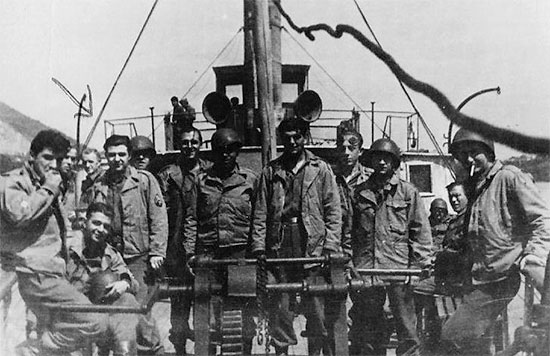
Picture illustrating some personnel of the 60th Field Hospital aboard a ship. This could well be the Moselle or the Rhine rivers. The person identified by the arrow left, is Louis Loffredo, 32905282.
During the months of January and February 1945, numerous moves were made and Holding Units were employed to the limit. These had to be supported, if the cases were fresh and numerous, so one or two ANC Officers and a few Technicians were called upon. Meanwhile, the Surgeons had to return to the hospital site to care for the patients. Unfortunately, changing of units, moving around, and supplementing extra personnel where necessary, could not always be controlled by the CO. Decisions had to be taken quickly, and risks evaluated. At Bertrix, Belgium, the Chief Nurse who liked to stay back and support her patients, had Holding Hospitals change sites three times. Two patients with lung injuries developed what clinically appeared to be pneumonia and had to be kept three weeks before they could make the 40-mile ride to the Evacuation Hospital that had meanwhile moved forward! Each of the patients, although with pneumonia, lived and was successfully evacuated after 21 days. About 15 other severe cases, including a Lt. Colonel, past 50, with a through-and- through wound of the belly which had perforated his colon and damaged the liver, were all driven to the nearest Evacuation Hospital.
Late February and early March 1945, US forces breached the Siegfried Line. TUSA’s XII Corps drove toward the Rhine river and took up positions in that area. XX Army Corps captured Trier. The campaign to capture the Saar basin and the southern part of the Rhineland was to follow about mid-March. Initial fighting was relatively heavy, but as soon as the Rhine crossings were assured, the Wehrmacht on the west side of the Rhine began to collapse. Many casualties were received by the widely scattered Army hospitals, and because of their increasing numbers, the problem of moving them all, remained as had happened in France, acute.
Infantry and Armored Divisions needed more transport to keep up with the retreating Germans and to haul the many enemy PWs back. Because of the rapid advance and the fact that Army Corps could seldom spare transportation, many of the hospitals were left behind the Divisions they were supposed to medically support.
During March of 1945 alone, the 60th Fld Hosp admitted 172 non-transportable cases, with the largest number coming from the fighting along the Saar and the Moselle rivers. Later in the month, many casualties came in, with injuries and wounds caused by enemy snipers, anti-personnel mines, and booby traps, resulting from the localized fighting necessary to clean up pockets of enemy resistance.
First Platoon crossed the Rhine below Koblenz, on March 31, 1945 in support of the 76th Infantry Division. Second and Third Platoon crossed the Rhine river on April 3 and 4, respectively, in support of the 80th and 65th Infantry Divisions, and against light enemy resistance. Third US Army now moved to Leipzig and Chemnitz, then turned its front over to FUSA, while now advancing into Bavaria and Austria. Every bit of motor transportation was now reserved to bring up supplies and take back prisoners. Field Hospitals were now, more than ever left in the rear, and with their limited motor pool, were in no condition to provide the necessary transportation and evacuation. Another 178 non-transportable cases were received during the month of April 1945. Division Surgeons could not take any decision and depended on Corps Surgeons for the movement of attached hospitals. The Army Corps Surgeons in turn could do little. However, by using the Holding Units, by pooling, by shuttling, and by the use of any available transport, the Field Hospitals succeeded in keeping quite reasonably well forward.
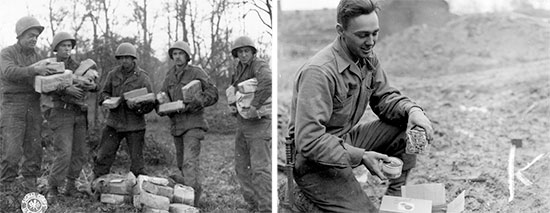
26 November 1944, Bastogne, Belgium. Left: Unidentified GIs receive bundles from home while stationed in Bastogne, a welcome treat for the coming Christmas. Right: 3 December 1944, another soldier opens a food package received from his next-of-kin in the Zone of Interior.
By the early part of May 1945, it was clear that the end was in sight. The three Hospital Units (Platoons) had moved as far east as the advance of the troops permitted, and fighting stopped almost everywhere on May 8. Second Platoon, supporting the 71th Infantry Division; and Third Platoon, servicing the 65th Infantry Division, received between them 55 non-transportable patients. Later on, between early May and mid-June, Second Platoon took over hospitalization of a large group of Displaced Persons in Wels, Austria. It really did an excellent job, supervising 5 temporary hospitals that at the beginning of May 1945 contained approximately 2500 starving and sick Jewish refugees. The majority of these patients were suffering from typhus and dysentery. Second Platoon personnel had to organize and supervise the delousing, the isolation, the treatment, and the feeding of all these people. At one time, over 500 cases of typhus were present in the hospital and the German barracks at Wels. The small 60th Field Hospital Platoon was able to carry out its work by calling Austrians to furnish help, by requisitioning all available Hungarian medical personnel, both commissioned and enlisted, in the area, primarily all members belonging to captured enemy troops, and by using certain German Sanitary Companies that had recently surrendered. These people were fist screened and then carefully supervised and controlled by US Medical Department Officers.
Following V-E Day, food was distributed to the (German) hospitals by the Military Government and supplies, both quartermaster and medical, were mostly drawn from captured German military depots. The work was done efficiently and within three weeks, typhus was under control in the large barracks near Wels, where now 6500 DPs were housed. Some cases among the local population where some of the Displaced Persons had been sheltered were still occurring, but gradually dropped because of the determined efforts to delouse, isolate, and vaccinate any suspects. This effort was directed by one Officer detached from Second Platoon.
In June 1945, all Platoons were moved back into Bavaria, Germany, where they established small station-type hospitals in support of the 9th Infantry, the 71st Infantry, and the 14th Armored Divisions. the major work consisted in conducting appendectomies, dressing fractures, treating wounds, and handling automobile and road accidents, setting up wards for cases requiring up to maximum 10 days of treatment. Many cases were quickly returned to the Divisions upon recovery. X-ray, laboratory, and pharmacy personnel were well solicited. Outpatients were treated by a separate dispensary. The splendid housing facilities given the Platoons of the command, all with electric lighting, cold and hot showers, and plenty of room for quarters and freedom of movement were most welcome.
Following the last campaign and the defeat of Nazi Germany, several important experiences were encountered by the 60th during its last six months of operation in Germany and Austria.
Divisional Surgeons and organic Medical Battalion Commanders were troubled by the unit’s lack of transportation, and this also applied to the Hospitals servicing the various Divisions. They tried to use the Holding Units to care for the non-transportable casualties and then only for a short duration without the necessary equipment and personnel of the parent Field Hospital. Surgeons often had to accompany these cases to the rear, which caused a loss of precious time and specialized personnel. It was further recommended to keep Field Hospitals under Corps command and place them in strategic positions as near to the front as possible, and when the haul of the seriously-wounded or injured became too great, the Army Corps Surgeon could then move another hospital ahead. In this way, all patients would be grouped and the Field Hospitals could remain nearer the frontline. The importance of this type of controlled patient care was already partially demonstrated in France, Germany, and Austria.
Another problem encountered was the terrible state of sanitation found in abandoned buildings to be occupied for hospital use. Not only the enemy but quite often the own infantry ruined the appliances, used the floor by covering it with straw, emptied the contents of drawers and desks for hidden weapons or loot. Upon arrival, this mess, filled with abandoned and broken furniture, and other trash, had to be thoroughly cleaned, blacked-out, heated, and prepared for receiving patients. Of course, it must be stated that when it became extremely cold and wet, the hospital lost more patients under tentage than in buildings. Therefore during winter and the subsequent fighting in the Ardennes and the Rhineland, buildings, when available, were used in various degrees of destruction.
Movement into such structures was extremely difficult, with the many staircases, and destructions, litter carry and moving heavy boxes and chests demanded a lot of determination and effort on part of the men. Later in the war, the 60th did receive new and smaller boxes from a German box factory and a wrecked enemy Hospital Train, including some different types procured from one Army supply depot. Mattresses were exceedingly bulky and difficult to keep clean. Finally, the personnel learned how to make a case out of tarpaulin to pack and carry these mattresses. Planning and procurement of equipment and supplies were of importance. Personnel of the command cleaned out over 100 different hospital sites, and it was always felt that any reasonable building was always better than a tent. One major difficulty was that line troops had a tendency to occupy and hold large buildings that in fact could make good hospitals, and conflicts erupted simply because higher authority did not seem necessary to move out a Signal Battalion, an Artillery Battery, a Quartermaster Service Company, or an Infantry or Armored Company. For example, when in Neufchâteau, Belgium, III Corps had to order a MP Company to move out of a school house which Third Platoon needed as a hospital.

December 1944, Bastogne Perimeter, Belgium. German Prisoners of war dig graves to bury American dead.
In order to conserve personnel, the Hospitals were allowed in January 1945 to supplement their own men with civilians from the towns where they were established. Details were organized under American supervision and gave a big boost enabling the command to run a reasonably neat and clean installation.
Some personnel had to be shifted among the different Platoons. It was essential to keep and distribute the available skills in order to have sufficient Medical and Surgical Technicians on the wards and in the operating rooms. Operating three separate messes remained a problem but somehow the Platoons always managed to keep enough cooks on hand for the job.
The initial T/E as drafted by the War Department did not furnish a Field Hospital enough equipment to do what was required of it when supporting a unit engaged in heavy combat. There were increases, but improvisation was always required The transportation problem always remained a serious one, increasing toward the end of the war. The Field Hospital, supposed to be a semi-mobile organization had barely enough transportation to move a single Platoon in one haul and not enough to compensate loss through accident or mechanical failure. But more was required, and often trucks and even ambulances had to be borrowed from other units. The distances between advance elements and the hospitals increased to such an extent that Division Surgeons would not always receive the assurance that their seriously wounded patients would receive the shock treatment, surgery and post-operative care they needed.
Surgical procedures, complex wounds, and combined injuries, necessitated the help of consultants used by Corps and Armies. Development of N-P cases required the setup of specialized organizations to treat such patients. Fortunately, the introduction of new drugs and medication did help to save more lives during this last conflict. The combination of the above measures enabled the 60th Field to save all but 20% of the cases that were received during the war.
Field Hospitals operating since the cessation of hostilities usually established small 50 to 75-bed-type station hospitals. For reasons of operation, they kept one attached Surgical Team, and thus allowed field units to find nearby a medical establishment capable of conducting major surgery.
Since the 250-gallon water trailers proved inadequate, the Hospital was provided with three 750-gallon water trucks that helped a great deal. Bath and shower units run by the Quartermaster Corps were set up nearby the installation (this mainly happened in France and Germany –ed). Laundry was handled by taking advantage of a nearby Evacuation Hospital, or the facilities of a temporarily attached QM Laundry unit. Sometimes an exchange system was available at a Medical Depot. Being constantly on the move during the advance into Germany and Austria caused quite a few problems, whereby the same laundry had to be used for long periods of time.
Messing was kept up adequately with the majority of rations provided by the Quartermaster services. Although the procurement of additional fresh food was fairly easy in liberated France, this became a problem when stationed in Germany, as the population had not much to eat themselves.
Nursing caused some hardships on the Nurses and the Technicians. Men made as good Nurses as women, but they required training of a particular type in order to be acquainted with Levine tubes, whole blood and plasma, blood pressure, special dressings and bandages, irrigation of wounds, and be alert when a patient’s condition turned bad. So ANC Officers were instructed to teach the Technicians.
Personnel who remained too long on a ward tended to become tired and short tempered. They were confronted with so many deaths, so many maimed men, and so many awful wounds that the best collapsed. It was recommended that no Nurse should work too long on such wards without a change from time to time. However, when such personnel began to get short tempered with the Officers and Enlisted Men, and they started to criticize everything unduly, this unpleasantness reflected immediately upon the attitude of the patients in their care.
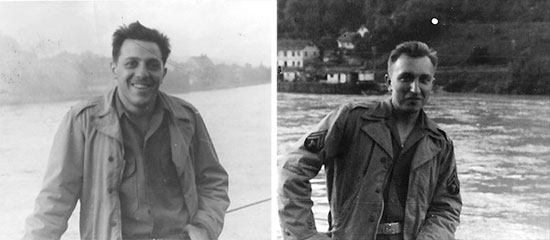
Personnel of the 60th Field Hospital. From L to R: Rudolph D. Carpino, 32811964 and Joseph A. Suly, 33672750 (both of the Second Hospitalization Unit). Unknown river in the background, Belgium or Germany.
1944 – Army Divisions medically supported
80th Infantry Division: activated July 15, 1942 at Camp Forrest, Tullahoma, Tennessee (Infantry Division Camp –ed). Staged at Camp Kilmer, Stelton, New Jersey, June 23, 1944 and departed New York POE July 1, 1944 for the United Kingdom. Landed in England July 7, 1944, and France August 3, 1944. Crossed into Luxembourg December 20, 1944, entered Germany February 18, 1945 and Austria May 5, 1945. Returned to the Zone of Interior January 3, 1946 and inactivated at Camp Kilmer, Stelton, New Jersey, January 4, 1946.
26th Infantry Division: inducted into Federal service and activated January 16, 1941 at Boston, Massachusetts, and moved to Camp Edwards, Falmouth, Massachusetts (Antiaircraft Artillery Training Center –ed), January 21, 1941. Staged at Camp Shanks, Orangeburg, New York, August 20, 1944 and departed New York POE August 27, 1944 for France. Landed in France September 7, 1944, and crossed into Luxembourg December 19, 1944. Entered Germany March 7, 1945, Austria May 2, 1945 and Czechoslovakia May 6, 1945 Inactivated in Germany December 29, 1945.
87th Infantry Division: activated December 15, 1942 Camp McCain, Grenada, Mississippi (Division Camp –ed). Staged at Camp Kilmer, Stelton, New Jersey, October 10, 1944, and departed New York POE November 4, 1944 for the United Kingdom. Arrived in England November 12, 1944, and landed in France December 5, 1944. Crossed into Belgium January 12, 1945 and into Luxembourg January 21, 1945. Back in Belgium February 3, 1945 and entered Germany March 16, 1945; Returned to the Zone of Interior July 11, 1945 and arrived at Fort Benning, Columbus, Georgia July 14, 1945, where inactivated September 21, 1945.
101st Airborne Division: activated August 15, 1942 at Camp Claiborne, Alexandria, Louisiana (Engineer Training Center & Infantry Division Camp –ed). Staged at New York POE August 31, 1943 and departed for the United Kingdom, where arrived September 15, 1943. Air-assaulted Normandy, France, June 6, 1944. Returned to England July 13, 1944. Air-assaulted Nijmegen, Holland, September 17, 1944. Moved to France November 28, 1944. Crossed into Belgium, December 18, 1944, and entered Germany April 4, 1945. Inactivated in France November 30, 1945.
5th Infantry Division: activated October 16, 1939 at Fort McClellan, Anniston, Alabama (Infantry Replacement Training Center –ed). Staged at Camp Kilmer, Stelton, New Jersey, April 22, 1942 and departed New York POE April 30, 1942 for Iceland where arrived May 11, 1942. Departed Iceland August 5, 1943 for Northern Ireland, where arrived August 9, 1943. Landed in France July 11, 1944. Entered Germany February 8, 1945, and Czechoslovakia May 1, 1945. Returned to the Zone of Interior July 19, 1945 and moved to Camp Campbell, Hopkinsville, Kentucky, where inactivated September 20, 1946.
35th Infantry Division: inducted into Federal service and activated December 23, 1940 at Lincoln, Nebraska, and moved to Camp Joseph T. Robinson, Little Rock, Arkansas (Infantry Replacement Training Center –ed), December 29, 1940. Staged at Camp Kilmer, Stelton, New Jersey, May 2, 1944 and departed New York POE May 12, 1944 for the United Kingdom. Arrived in England May 26, 1944, and landed in France July 6, 1944. Crossed into Belgium December 26, 1944 and into Luxembourg December 27, 1945. Back to Belgium January 8, 1945 and France January 19, 1945. Entered Holland January 31, 1945, and Germany February 4, 1945, Returned to the Zone of interior September 10, 1945, and moved to Camp Breckinridge, Morganfield, Kentucky, where inactivated December 7, 1945.
6th Armored Division: activated February 15, 1942 at Fort Knox, Louisville, Kentucky, and moved to Camp Chaffee, Fort Smith, Arkansas (Armored Division Camp –ed), March 15, 1942. Staged at Camp Shanks, Orangeburg, New York, February 3, 1944 and departed New York POE February 11, 1944 for the United Kingdom. Arrived in England February 23, 1944 and landed in France July 19, 1944. Crossed into Luxembourg December 29, 1944 and into Belgium December 30, 1944. Returned to France March 12, 1945 and Germany March 20, 1945. Returned to the Zone of Interior September 18, 1945 and moved to Camp Shanks, Orangeburg, New York where inactivated same date.
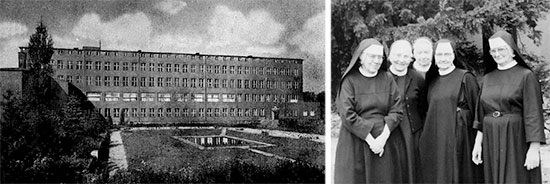
From L to R: Picture illustrating the Kloster “St. Maria Stern” (Convent) in Göggingen, near Augsburg, Germany. Priest and 4 Nuns pertaining to the St. Maria Stern Convent, Germany.
Operations Outline (period January 1, 1945 > June 30, 1945)
First Platoon
Bertrix, Belgium – January 3 to January 16, 1945. Supporting: 101st Airborne Division. Total Admissions: 69.
Berbourg, Grand-Duchy of Luxembourg – February 6 to March 4, 1945. Supporting: 76th Infantry Division. Total admissions: 40.
Gilzem, Germany – March 4 to March 10, 1945. Supporting: 76th Infantry Division. Total Admissions: 22.
Binsfeld, Germany – March 10 to March 12, 1945. Supporting: 76th Infantry Division. Total Admissions: 4.
Wittlich, Germany – March 12 to March 23, 1945. Supporting: 76th Infantry Division. Total Admissions: 19.
Maisborn, Germany – March 24 to March 31, 1945. Supporting: 76th Infantry Division. Total Admissions: 10.
Idstein, Germany – March 31 to April 9, 1945. Supporting: 76th Infantry Division. Total Admissions: 9.
Langelsalza, Germany – April 9 to April 11, 1945. Supporting: 76th Infantry Division. Total Admissions: 3.
Niedertreba, Germany – April 13 to April 14, 1945. Supporting: 76th Infantry Division. Total Admissions: 2.
Droysig, Germany – April 14 to April 15, 1945. Supporting: 76th Infantry Division. Total Admissions: 6.
Zeitz, Germany – April 15 to April 18, 1945. Supporting: 76th Infantry Division. Total Admissions: 16.
Burgstadt, Germany – April 18 to April 23, 1945. Supporting: 76th Infantry Division. Total Admissions: 8.
Plattling, Germany – April 30 to May 14, 1945. Supporting: 13th Armored Division. Total Admissions: 18.
Ingolstadt, Germany – June 11 to June 24, 1945. Supporting: 9th Infantry Division. Total Admissions: 13.
Sheyern, Germany – June 24 to June 30, 1945. Supporting: 9th Infantry Division. Total Admissions: 1.
Highest Admissions in one day: 16. Total number of Admissions for above period: 240.
Second Platoon
Bissen, Grand-Duchy of Luxembourg – January 1 to January 22, 1945. Supporting: 80th Infantry Division. Total Admissions: 82.
Esch-sur-Sûre, Grand-Duchy of Luxembourg – January 22 to January 29, 1945. Supporting: 80th Infantry Division. Total Admissions: 24.
Eels, Grand-Duchy of Luxembourg – January 29 to February 19, 19455. Supporting: 80th Infantry Division. Total Admissions: 63.
Diekirch, Grand-Duchy of Luxembourg – February 19 to March 12, 1945. Supporting: 80th Infantry Division. Total Admissions: 46.
Neunkirchen, Germany – March 18 to March 27, 1945. Supporting: 80th Infantry Division. Total Admissions: 32.
Bretzenheim, Germany – March 28 to April 4, 1945. Supporting: 80th Infantry Division. Total Admissions: 12.
Wabern, Germany – April 4 to April 8, 1945. Supporting: 80th Infantry Division. Total Admissions: 4.
Gotha, Germany – April 8 to April 13, 1945. Supporting: 80th Infantry Division. Total Admissions: 47.
Weimar, Germany – April 13 to April 19, 1945. Supporting: 80th Infantry Division. Total Admissions: 22.
Amberg, Germany – April 24 to April 27, 1945. Supporting: 71st Infantry Division. Total Admissions: 8.
Straubing, Germany – April 30 to May 6, 1945. Supporting: 71st Infantry Division. Total Admissions: 4.
Wels, Austria – May 7 to June 15, 1945. Supporting 71st Infantry Division. Total Admissions: 28.
Göggingen, Germany – June 15 to June 30, 1945. Supporting: 71st Infantry Division. Total Admissions: 40.
Highest Admissions in one day: 19. Total number of Admissions for above period: 520.
Third Platoon
Neufchâteau, Belgium – January 4 to February 4, 1945. Supporting: 17th Airborne Division. Total Admissions: 270.
Weilerbach, Grand-Duchy of Luxembourg – February 20 to March 6, 1945. Supporting: 5th Infantry Division. Total Admissions: 83.
Boulay, France – March 6 to March 21, 1945. Supporting: 65th Infantry Division. Total Admissions: 47.
Saarlautern, Germany – March 21 to March 24, 1945. Supporting: 65th Infantry Division. Total Admissions: 4.
Neunkirchen, Germany – March 24 to March 26, 1945. Supporting: 65th Infantry Division. Total Admissions: 1
Eschwege, Germany – April 4 to April 8, 1945. Supporting: 65th Infantry Division. Total Admissions: 13.
Arnstadt, Germany – April 13 to April 17, 1945. Supporting: 65th Infantry Division. Total Admissions: 1.
Altdorf, Germany – April 22 to April 25, 1945. Supporting: 65th Infantry Division. Total Admissions: 6.
Alling, Germany – April 26 to April 29, 1945. Supporting: 65th Infantry Division. Total Admissions: 25.
Regensburg, Germany – April 29 to May 6, 1945. Supporting: 65th Infantry Division. Total Admissions: 1.
Enns, Austria – May 7 to May 18, 1945. Supporting: 65th Infantry Division. Total Admissions: 6.
Linz, Austria May 18 to June 19, 1945. Supporting: 65th Infantry Division. Total Admissions: 9.
Kraiburg, Germany – June 9 to June 30, 1945. Supporting: 14th Armored Division. Total Admissions: 124.
Highest Admissions in one day: 36. Total number of Admissions for above period: 590.
Totals for the 3 Platoons.
Maximum Admissions in one day: 51. Grand total number of Admissions: 1350.
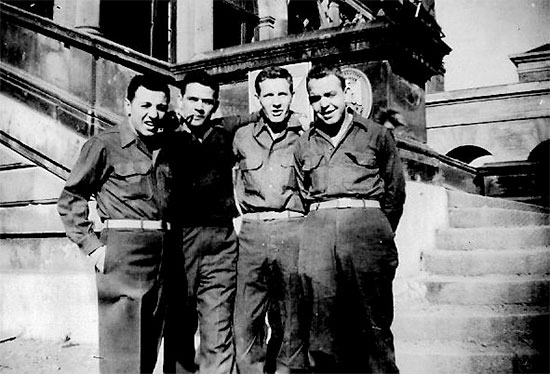
Group of personnel of the 60th Field Hospital, during a sightseeing trip. We believe this to be some place in Germany …
1945 – Army Divisions medically supported
76th Infantry Division: activated June 15, 1942 at Fort George G. Meade, Baltimore, Maryland (Army Ground Forces Replacement Center –ed). Staged at Camp Myles Standish, Boston, Massachusetts, November 30, 1944 and departed Boston POE December 10, 1944 for the United Kingdom. Arrived in England December 20, 1944. Landed in France January 12, 1945 and crossed into Belgium January 23, 1945. Entered Luxembourg January 25, 1945, and Germany March 1, 1945, where inactivated and disbanded August 31, 1945.
13th Armored Division: activated October 15, 1942 at Camp Beale, Marysville, California (Division Camp –ed), eventually transferred to Camp Bowie, Brownwood, Texas (Armored Division Camp –ed), December 18, 1943. Staged at Camp Kilmer, Stelton, New Jersey, January 14, 1945 and departed New York POE January 17, 1945 for France. Arrived in France January 30, 1945. Crossed into Germany April 3, 1945. Returned to the Zone of Interior July 23, 1945 and moved to Camp Cooke, Oceano, California (Division Camp –ed) July 30, 1945, where inactivated November 15, 1945.
9th Infantry Division: activated August 1, 1940 at Fort Bragg, Fayetteville, North Carolina (Field Artillery Replacement Training Center –ed). Staged at New York POE and departed December 11, 1942 for North Africa. Arrived in Algeria December 25, 1942. Landed in Sicily, July 31, 1943. Returned to England November 25, 1943 and landed in France June 10, 1944. Crossed into Belgium September 2, 1944. Entered Germany September 14, 1944, where it remained active through 1946.
71st Infantry Division: activated July 15, 1943 at Camp Carson, Colorado Springs, Colorado (Division Camp –ed). Staged at Camp Kilmer, Stelton, New Jersey, January 14, 1945 and departed New York POE, January 26, 1945 for France. Arrived in France, February 6, 1945. Entered Germany, March 24, 1945, and crossed into Austria, May 4, 1945. Returned to the Zone of Interior, March 10, 1946 and moved to Camp Kilmer, Stelton, New Jersey (Staging Area for New York POE –ed), where inactivated March 11, 1946.
17th Airborne Division: activated April 15, 1943 at Camp Mackall, Hoffman, North Carolina (Airborne Center –ed), and transferred to Camp Forrest, Tullahoma, Tennessee (Infantry Division Camp –ed) March 24, 1944. Staged at Camp Myles Standish, Boston, Massachusetts, August 12, 1944 and departed Boston POE August 20, 1944 for the United Kingdom. Arrived in England August 25, 1944 and flown to Reims, France, December 24, 1944. Crossed into Belgium December 25, 1944 and returned to France February 11, 1945. Air-assaulted Wesel, Germany, March 24, 1945. Returned to the Zone of Interior September 15, 1945, and inactivated at Camp Myles Standish, Boston, Massachusetts (Staging Area for Boston POE –ed), September 16, 1945.
65th Infantry Division: activated August 16, 1943 at Camp Shelby, Hattiesburg, Mississippi (Division Camp –ed). Staged at Camp Shanks, Orangeburg, New York, December 31, 1944 and departed New York POE, January 10, 1945 for France. Arrived in France January 21, 1945 and entered Germany March 20, 1945, and Austria May 4, 1945, where it was finally inactivated and disbanded August 31, 1945.
14th Armored Division: activated November 15, 1942 at Camp Chaffee, Fort Smith, Arkansas (Armored Division Camp –ed), eventually transferred to Camp Campbell, Hopkinsville, Kentucky (Armored Division Camp –ed), January 19, 1944. Staged at Camp Shanks, Orangeburg, New York, October 6, 1944 and departed New York POE October 14, 1944 for France. Arrived in France October 30, 1944 and crossed into Germany March 19, 1945. Returned to the Zone of Interior September 16, 1945 and moved to Camp Patrick Henry, Oriana, Virginia, (Staging Area for Hampton Roads POE –ed), where inactivated same date.
Enlisted Men Roster (Second Hospitalization Unit only) incomplete:
| Arthur J. Bair, MD, 33431572 | Normand H. Bilodeani, MD, 31175693 |
| Andrew Boda, MD, 32588751 | William T. Brooks, MD, 36589362 |
| Robert J. Carroll, MD, 32605096 (Pfc) | Rudolph D. Carpino, MD, 32811964 |
| Parker J. Christianberry, MD, 35730154 | Charles C. Compton, MD, 32919936 |
| John P. D’Angelo, MD, 33780909 | William H. Deacon, MD, 33778749 |
| Vincent Dendrea, MD, 32959516 | Peter J. De Vito, MD, 32889858 |
| Robert Dragani, MD, 32905294 | John M. Driscoll, MD, 36601625 |
| Martin Drucker, MD, 32499172 | John J. Dunbar, MD, 32932226 |
| Gerald J. Eddy, MD, 31356496 | Frederick T. Fava, MD, 32999890 |
| Alfred J. Francis, MD, 33594442 | Dominick Gabriel, MD, 31334709 |
| David L. Gammons, MD, 336319798 | Marvin B. Gordy, MD, 33599928 |
| Norio Hara, MD, 39158223 | Phillip J. Hendrickson, MD, 36461548 |
| Michael J. Innello, MD, 31356496 | Carl J. Jensen, MD, 32931956 |
| Richard R. Kent, MD, 34580750 | Alfred Lanciani, MD, 31354982 |
| Louis Loffredo, MD, 32905282 | James Mango, MD, 36750089 |
| Kenneth L. McCarthy, MD, 12217413 | John Medeiros, MD, 31383522 |
| Barkley D. Orr, MD, 31334747 | Clarence Parriah, MD, 33636811 |
| Walter O. Richards, MD, 33604115 | L. V. Schmidt, MD, 36485481 |
| Harley E. Shoaff, MD, 33435661 | Domenico A. Sionne, MD, 31293293 |
| Stephen E. Smith, MD, 35608935 | Cedric O. Snyder, MD, 39007418 |
| Stanley Storper, MD, 32854436 | Joseph A. Suly, MD, 33672750 |
| Guy R. Williams, MD, 38436083 |
Finale:
The 60th Field Hospital finally returned to the Zone of Interior, departing the European Theater November 20, 1945, and arriving December 2, 1945 in the United States. The MRC authors have been unable to determine from which Continental Port the unit sailed for the United States (this could have been Le Havre, Northern France, or Marseille, Southern France).
Campaign Awards – 60th Field Hospital
Northern France
Rhineland
Ardennes-Alsace
Central Europe
Special Awards – 60th Field Hospital
Meritorious Service Unit Plaque
Our sincere thanks go to Isobel Carroll, widow of Private First Class Robert J. Carroll (ASN:32605096) who served with the Second Hospitalization Unit, 60th Field Hospital in the European Theater of Operations. Isobel kindly provided the MRC Staff with a lot of vintage reports, a partial roster, as well as a number of pictures illustrating the Hospital, which helped them to edit a concise Unit History of the organization. Thank you again. The MRC Staff are still looking for a complete Personnel Roster as well as the date of the unit’s return to the Zone of Interior.
